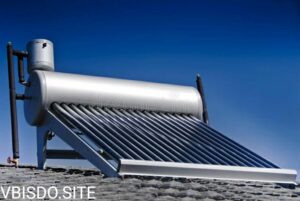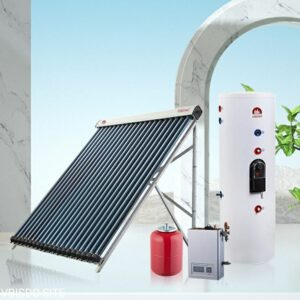As we progress through 2025, homes and businesses are increasingly turning to solar water heater panels as a sustainable, cost-effective alternative to conventional water heating systems. These panels not only help reduce utility bills but also support a cleaner environment by utilizing renewable solar energy.
This guide covers everything you need to know—from how solar water heater panels work to their advantages, types, installation, maintenance, and cost breakdown. Whether you’re upgrading an old system or installing a new one, this comprehensive guide will help you make informed decisions.
🌞 What Is a Solar Water Heater Panel?
A solar water heater panel—also called a solar thermal collector—captures sunlight and converts it into heat, which is then used to warm water for residential, commercial, or industrial use. Unlike photovoltaic (PV) panels that generate electricity, these panels focus solely on water heating.
Basic Components Include:
-
Solar Collector: Typically mounted on rooftops to absorb sunlight.
-
Storage Tank: Holds the heated water.
-
Circulation System: Transfers heated water or heat-transfer fluid between the panel and the tank.
-
Pump and Controller (for active systems): Help regulate flow and efficiency.
Even in cooler climates, properly designed systems can efficiently provide hot water throughout the year.
⚙️ How Does a Solar Water Heater Panel Work?
The process is simple yet effective:
-
Sunlight hits the solar collector (usually roof-mounted).
-
Heat is transferred to water or a heat-transfer fluid inside the collector.
-
Heated liquid travels through pipes into an insulated storage tank.
-
Stored hot water is available for use in showers, laundry, dishwashing, and more.
-
Backup heating from electricity or gas can be used during cloudy days or high demand periods.
This closed-loop system minimizes energy waste and reduces reliance on fossil fuels.
🔍 Types of Solar Water Heater Panels
There are two main categories of solar water heating systems:
1. Active Solar Heating Systems
Use mechanical parts like pumps and controllers for circulation.
-
Direct Circulation Systems:
-
Circulate household water through collectors.
-
Best suited for warm climates.
-
-
Indirect Circulation Systems:
-
Use antifreeze fluids heated in collectors.
-
Heat is then transferred to water via a heat exchanger.
-
Ideal for cold climates with freezing temperatures.
-
2. Passive Solar Heating Systems
No pumps or controllers—rely on natural circulation.
-
Integral Collector Storage (ICS):
-
Combine collection and storage in one unit.
-
Suitable for warm, non-freezing regions.
-
-
Thermosyphon Systems:
-
Use natural convection for water flow.
-
Require sturdy roof structures due to tank weight.
-
🔬 Types of Solar Collectors
Choosing the right collector affects system efficiency:
-
Flat Plate Collectors:
-
Most common.
-
Insulated box with a dark absorber plate under a glass cover.
-
Effective in most climates.
-
-
Evacuated Tube Collectors:
-
Glass tubes with vacuum insulation.
-
Highly efficient in colder and cloudier areas.
-
-
Unglazed Collectors:
-
Typically used for pool heating.
-
Simple, cost-effective, and less insulated.
-
✅ Benefits of Solar Water Heater Panels
1. Significant Energy Savings
Water heating typically makes up 25–30% of home energy use. Solar systems can drastically reduce or eliminate these costs.
2. Eco-Friendly
Reduces dependence on fossil fuels, lowering greenhouse gas emissions and your carbon footprint.
3. Low Maintenance
With few moving parts, especially in passive systems, maintenance needs are minimal—usually limited to an annual checkup.
4. Long Lifespan
Most systems last 15–20 years or more, often outliving traditional water heaters.
5. Government Incentives
In 2025, many governments offer tax credits, rebates, and other incentives—making installation more affordable than ever.
🔍 Is a Solar Water Heater Panel Right for You?
Before investing, consider the following:
-
Sunlight Availability: South-facing roofs with minimal shading work best.
-
Roof Strength: Must support the weight of the panel and storage tank.
-
Hot Water Usage: Larger households will benefit more from solar heating.
-
Climate: Choose a system designed for your local temperature range.
-
Space: You’ll need sufficient roof space for collectors and an area for the storage tank.
A professional installer can help assess the feasibility of your location.
🧰 Installation Guide: What to Expect
Though professional installation is recommended, here’s an overview of what the process typically involves:
-
Site Evaluation: Assess solar access, plumbing layout, and roof condition.
-
System Sizing: Determine collector area and tank capacity based on household usage.
-
Permits & Incentives: Obtain necessary permits and check for available rebates.
-
System Installation: Mount panels, connect plumbing, and integrate with your current water system.
-
Testing & Commissioning: Ensure proper operation and heat transfer.
Timeline: Installation typically takes 1–3 days depending on system complexity.
🧼 Maintenance Tips
To ensure long-term performance:
-
Annual Inspection: Check for leaks, corrosion, and insulation wear.
-
Flushing: Prevent scale buildup, especially in hard water areas.
-
Pump & Controller Checks: In active systems, ensure electronics work correctly.
-
Antifreeze Levels: For cold climates, check heat-transfer fluid levels in indirect systems.
Routine upkeep ensures efficiency and extends lifespan.
💰 2025 Cost and ROI
Installation Costs:
-
Typically range between $3,000 to $7,000 depending on system size and complexity.
Savings:
-
Annual utility savings range from $250 to $600 or more.
Payback Period:
-
Most homeowners recover costs in 4 to 8 years, especially with incentives.
As energy prices rise, the return on investment continues to grow, making 2025 an ideal year to switch.
❌ Debunking Common Myths
-
Myth 1: Solar heaters don’t work in cold climates.
-
Fact: Evacuated tube systems are designed to perform in snowy, cloudy weather.
-
-
Myth 2: Solar systems are too expensive.
-
Fact: Incentives and lower solar technology costs have made them affordable for most homeowners.
-
-
Myth 3: Not enough hot water is produced.
-
Fact: Properly sized systems meet or exceed typical household hot water needs.
-
🌱 Final Thoughts
Installing a solar water heater panel in 2025 is more than just a smart financial decision—it’s a commitment to sustainability and energy independence. Whether you’re retrofitting an old system or outfitting a new home, solar thermal technology offers a reliable, clean, and long-term hot water solution.

☀️ Ready to Make the Switch?
Now is the perfect time to install a solar water heater panel in your home or business. With rising energy costs and government-backed incentives in 2025, investing in solar hot water makes both ecological and financial sense.
📌 SEO Tags:
-
solar water heater panel
-
solar hot water system
-
solar thermal panel 2025
-
renewable water heating
-
eco-friendly water heating
-
solar energy for hot water
-
cost of solar water heater
-
solar heater installation guide
-
solar water heating system types
-
best solar water heaters 2025
Let me know if you’d like this formatted for WordPress, or if you want an infographic, checklist, or shorter summary version!
